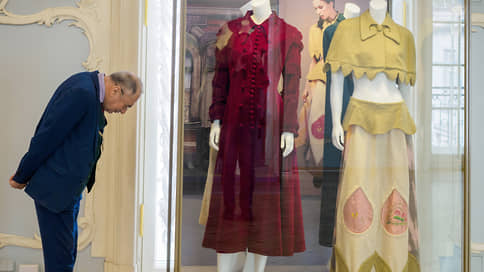theater and fashion of Konstantin Goncharov”
[ad_1]

The exhibition “A Strict Young Man: Theater and Fashion of Konstantin Goncharov” has opened in the Hermitage. The exhibition includes 14 theatrical and personal costumes donated to the museum. He talks about why it is so important to museumify the art of the 1980s–1990s right now. Kira Dolinina.
In history, everything came together almost perfectly with this gift. The chief critic and theorist of the New Academy of Fine Arts, Doctor of Science and employee of the Russian Museum, Ekaterina Andreeva, donated to the Hermitage 14 works by the most famous fashion designer of this group and, perhaps, one of the most notable couturiers of “alternative” art of the 1980–1990s – Konstantin Goncharov ( 1969–1998). Together with the items previously transferred by her and other owners, the number of works by Goncharov in the Hermitage now totals 43 items. Another 30 remain in private hands. Such a noticeable inclusion of modern Russian fashion in the Hermitage collection became possible solely thanks to Nina Tarasova, the curator of Russian costume, who in 2015–2016 approached St. Petersburg fashion designers with a proposal to donate works to the Fashion Museum, which the Hermitage had conceived. And indeed, the Fashion Museum has already partly become a reality: in the depository in Novaya Derevnya, a form of open storage is practiced, which makes it possible to show things to viewers in a much larger quantity than just in a permanent exhibition.
Konstantin Goncharov entered the Fashion Museum easily. His clothes, even those sewn for private customers, are so eloquent, pathetic, as if carved from hard materials, and not from the softest velvets, silks and velors, that their theatrical nature does not need proof. And they look completely natural next to costumes actually made for a theater or art project. As, indeed, next to the main content of the Hermitage costume fund – court dresses and uniforms, because life at the imperial court is the same theater.
Goncharov appeared in the circle of Timur Novikov, then not at all “new academic”, but on the contrary, sultry avant-garde, in the late 1980s. Close witnesses and historians agree that the meeting between the already eminent artist and the boy tailor from the men’s atelier was one of the reasons for the tectonic shift in the evolution of Novikov’s ideas from modernism to classics. The view, of course, is too simplifying, but quite correct: the chronology coincides, and the mutual influence of Novikov and Goncharov is easily proven not so much by the changed style of the first (it was simply impossible to stylistically influence Timur Novikov, who has the rare gift of generating new concepts that involve a lot of other artists in his orbit ), as well as the appearance of projects of the New Academy, which could not have happened without Goncharov’s art. First of all, this concerns the art project “Passiones Luci” (“Golden Donkey”, 1994) and Sergei Vikharev’s ballet “Leda and the Swan” (1995). Costumes from both productions were included in the Hermitage collection.
The display of theatrical works along with private commissions perfectly demonstrates the features of Goncharov’s style: he does not sew, but arranges his things, they have more architectonics than softness or femininity. Outwardly, wearing these things seems like putting on armor, although their owners say that in fact they are very comfortable. The coarse cloth is hemmed with the most delicate lining; heavy velvet is lightened with inserts of feathers, shells, and embroidery; wool is adjacent to silk or tulle. Even brown fabric for a school uniform, the nightmare of any Soviet student, Goncharov was able to turn into ceremonial attire of some incredible luxury. In fact, before big projects, he most often sewed from God knows what; the search for materials was almost the longest part of the dress-making process.
Fame managed to catch up with Goncharov in the mid-90s, and already in 1998 he was dying: photographs in Vogue, shows in Europe, his atelier “Strict Young Man,” orders. To some extent, he was almost the most natural member of the new academic crowd: both because he took his art very seriously, and because in this art there was no postmodern pose, his “classics” were the dream of a boy from a sewing college about palaces That is why his works are so good in a real palace – either in Mramorny, where he exhibited more than once, or in the foyer of the Hermitage Theater, where he dreamed of showing the costumes for The Golden Donkey.
Now they are there. Not all – the costumes of the main characters of Apuleius are in the collection of the Russian Museum, which is now embarrassed by them and at the exhibition last summer shyly sewed up the tails of the cloak so that, God forbid, no one would see his golden penis on the donkey. The fact that without this “subject” Apuleius’s plots make no sense at all was not taken into account. In this sense, the Hermitage is stricter towards the classics and their texts. Ekaterina Andreeva, as a donor and researcher, believes that “Goncharov’s costumes in the Hermitage are completely at home for the first time. His unique style is very Hermitage-like: it embodies the entire world culture from antiquity to modernism with elements of primitive images, art and materials of the East.” You can’t argue, but the most important thing in this story is the need for urgent museumification of works that today are not only not mainstream, but in some eyes are almost outcasts. The history of art does not tolerate subtraction – and the winner will be the museum that is ready to preserve it without looking at fashion or the political agenda.
[ad_2]
Source link






